How to Plant Maple Tree: Cultivating for Sustainable Harvest
- March 25, 2024
- 0 comment
How to Plant Maple Tree provides a detailed walkthrough for gardeners and landscapers aiming to add the beauty of maple trees to their spaces. Known for their striking autumn hues and resilience, maple trees, including varieties like the grand Sugar Maple and the elegant Japanese Maple, demand specific planting techniques for optimal health and growth. This guide outlines the essential steps, from selecting the right location to caring for the tree post-planting, ensuring your maple thrives and enhances your landscape with its vibrant colors and robust nature.
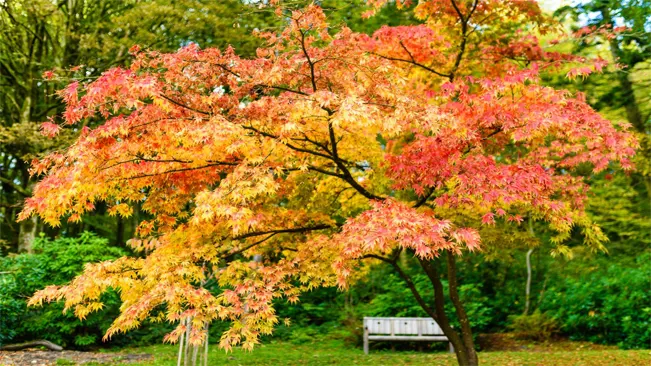
Maple Tree Benefits
| Benefit | Description |
|---|---|
| Aesthetic Appeal | Maple trees are known for their stunning fall foliage, ranging from bright yellows to deep reds, adding beauty and seasonal interest to landscapes. |
| Shade and Cooling | Their broad canopy provides ample shade, reducing temperatures and creating comfortable outdoor spaces. This can also lead to energy savings in homes during summer. |
| Air Quality Improvement | Like all trees, maples play a role in air purification by absorbing pollutants and emitting oxygen, contributing to cleaner air. |
| Wildlife Habitat | Maple trees provide habitat and food for various wildlife, including birds and small mammals. Their flowers and seeds are particularly beneficial. |
| Carbon Sequestration | They help combat climate change by absorbing carbon dioxide from the atmosphere, storing carbon in their wood, and reducing the overall carbon footprint. |
| Soil Erosion Control | The root systems of maple trees help stabilize soil and prevent erosion, especially in sloped areas. |
| Increased Property Value | Trees, including maples, can enhance the overall value of a property due to their aesthetic and environmental benefits. |
| Maple Syrup Production | Some species, like the Sugar Maple, can be tapped for sap, which is boiled down to produce maple syrup, a popular and natural sweetener. |
| Educational Opportunities | Maple trees can be used as educational tools to teach about nature, biology, and environmental stewardship, especially during events like maple syrup harvesting. |
| Biodiversity Preservation | By planting native maple species, gardeners and landscapers contribute to the preservation of local biodiversity and ecological balance. |
List on How To Plant Maple Tree
- Choosing the Right Location
- Preparing the Site
- Watering
- Mulching and Fertilizing
- Staking (If Necessary)
- Ongoing Care
Choosing the Right Location
Maple trees thrive in well-drained soil with ample sunlight. Avoid planting near buildings or other trees as maples need space to grow. Consider the mature size of your maple to avoid future issues.
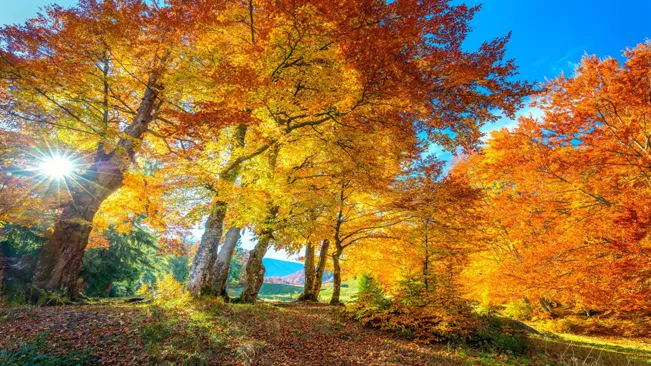
- Understanding Soil Requirements
- Well-Drained Soil: Maple trees need soil that allows water to percolate through without waterlogging. Excess moisture can lead to root rot, a common issue in maple trees. You can improve drainage by amending the soil with organic matter.
- Soil pH: Most maple species prefer slightly acidic to neutral pH levels. It’s beneficial to test the soil pH before planting and adjust it if necessary using soil amendments.
- Sunlight Exposure
- Sunlight Needs: Maple trees generally thrive in full sun to partial shade. They need at least 4-6 hours of direct sunlight daily. However, some varieties, like Japanese Maples, prefer some afternoon shade to protect their leaves from scorching.
- Seasonal Considerations: In regions with hot summers, some shade in the afternoon can prevent leaf burn, especially in younger trees.
- Spacing and Location
- Space Considerations: Maples can grow quite large, so it’s crucial to plant them where they have enough room to expand. This includes space both above ground for branches and below ground for roots.
- Proximity to Structures: Avoid planting maple trees too close to buildings, sidewalks, or driveways. Their roots can be invasive and may cause damage to foundations or pavements.
- Growth and Mature Size: Consider the mature height and spread of the maple variety you choose. Larger species like the Sugar Maple need more space, while smaller varieties like the Japanese Maple are suitable for smaller yards.
- Environmental Impact
- Wind and Storm Resistance: While many maple trees are sturdy, some varieties can be susceptible to breakage in high winds or ice storms. Planting them in sheltered locations can minimize damage.
- Microclimate Considerations: Every garden has microclimates. Areas near south-facing walls may be warmer, which can affect the growth and health of the maple.
- Future Growth and Landscaping Plans
- Long-Term Planning: Think about how the tree will fit into your landscape as it grows. Will it block views? Will it complement other plantings?
- Compatibility with Other Plants: Maples have extensive root systems that can compete with other plants for nutrients and water. Ensure other nearby plants or lawn areas are compatible with this.
Preparing the Site
Before planting, test the soil pH; maples prefer slightly acidic to neutral soil. Clear the area of weeds and debris. Dig a hole twice the width of the root ball and just as deep. Mix some organic compost with the removed soil to provide nutrients.
- Testing Soil pH
- Importance: Maple trees prefer slightly acidic to neutral soil (pH between 5.5 and 7.5). The right pH is crucial for nutrient uptake.
- How to Test: You can use a simple soil pH testing kit available at garden centers. This involves taking a soil sample and either using a test strip or a liquid that changes color based on the pH.
- Clearing the Area
- Objective: Removing weeds and debris ensures that your maple tree won’t have to compete for nutrients and water.
- Tips: Clear a generous area around where you plan to plant. This helps prevent damage from mowers or trimmers and reduces competition from grass and weeds.
- Digging the Hole
- Size: The hole should be twice as wide as the root ball of your maple sapling but only as deep. This size encourages the roots to spread out horizontally and establishes a solid foundation.
- Technique: Keep the dug-up soil nearby as you’ll need it to fill the hole. The sides of the hole should be a bit rough, not smooth, to encourage roots to penetrate into the surrounding soil.
- Enhancing the Soil
- Organic Compost: Mixing organic compost with the excavated soil improves its fertility and structure. Compost provides essential nutrients and improves soil aeration and water retention.
- Proportion: A good rule of thumb is to mix about 1/3 compost with 2/3 of the native soil. This ratio ensures that the tree gradually adapts to the native soil as its roots grow beyond the amended soil.
- Considerations for Heavy Clay or Sandy Soils
- Clay Soils: They can retain too much water, leading to root rot. Amend with compost and consider raised planting to improve drainage.
- Sandy Soils: They drain quickly and might not hold enough water. Enhance with organic matter to increase water retention.
- Final Touches
- Before Planting: Water the hole lightly. This prepares the soil and provides a moist environment for the roots.
- After Planting: Don’t tamp the soil too firmly as it can compact it and reduce aeration.
Planting the Tree
Carefully remove the maple from its container. Gently loosen the roots and place the tree in the center of the hole. Ensure that the top of the root ball is level with the surrounding soil. Fill the hole with the soil-compost mix, tamping down gently to remove air pockets.
Removing the Maple from Its Container
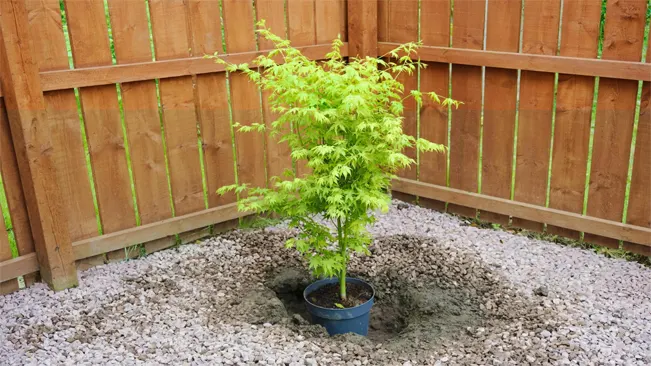
- Be careful during this process as rough handling can damage the roots. If the tree is in a plastic container, gently tip it sideways and tap the bottom and sides to loosen the soil.
- If the tree is balled and burlapped (wrapped in burlap), place the tree next to the hole, and then gently remove the burlap and any wires. It’s essential to keep the root ball intact.
Loosening the Roots
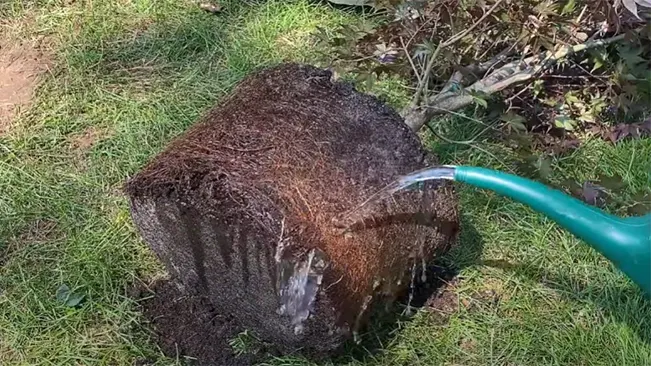
- This step is crucial, especially if the tree is pot-bound with roots circling the inside of the pot.
- Gently tease the outer roots away from the root ball to encourage them to grow outward into the surrounding soil.
- Be careful not to break the larger roots, as this can harm the tree.
Positioning the Tree

- Place the tree in the center of the hole. The tree should be upright and straight.
- It’s important to ensure that the top of the root ball is level with the surrounding soil. Planting the tree too deep can lead to root rot and other problems, while planting it too high can expose roots and dry them out.
Filling the Hole
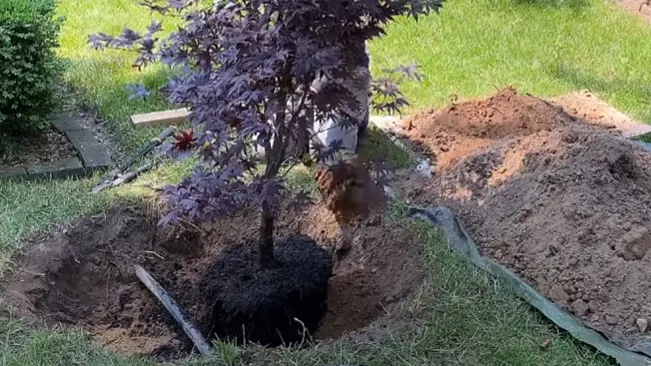
- Refill the hole with the soil-compost mix you prepared earlier. This mix should provide a balance of nutrients and improve soil structure.
- As you fill, gently tamp down the soil to eliminate air pockets, which can dry out roots and hinder root growth.
- Avoid compacting the soil too firmly, as this can make it hard for roots to penetrate and for water to permeate.
Final Adjustments
- Once the hole is filled, create a small mound or a basin around the base of the tree. This helps to direct water towards the roots.
- Ensure that the tree is still standing straight and make any necessary adjustments before the final tamping.
Watering
Water the tree generously after planting to settle the soil around the roots. Continue to water the tree deeply once a week, allowing the soil to dry out between waterings. Avoid over-watering as it can lead to root rot.
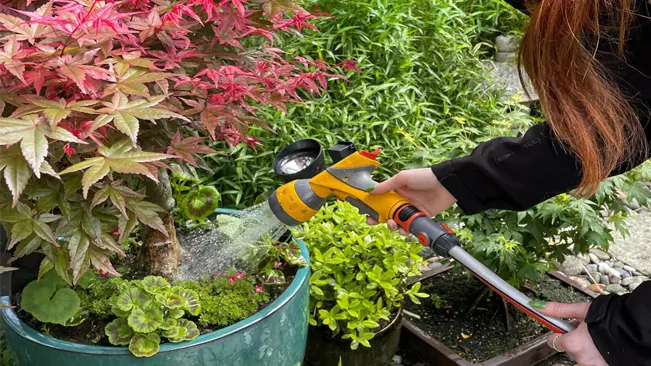
Initial Watering After Planting
- Importance of Initial Watering: Right after planting, it’s essential to water the maple tree generously. This initial watering helps to settle the soil around the roots and eliminates air pockets, which can hinder root growth.
- Method: Use a slow and steady watering method, like a drip hose or a watering can, to ensure that water penetrates deeply into the soil, reaching the entire root zone.
Regular Watering Schedule
- Frequency: After the initial watering, establish a regular watering schedule. For the first few weeks, water the tree deeply once a week. The goal is to encourage the roots to grow deeper into the soil, which promotes better drought tolerance in the long run.
- How to Water: When watering, aim to moisten the soil to a depth of at least 6 to 12 inches. This depth ensures that the water reaches the deeper roots. Avoid shallow watering, as it encourages roots to stay near the soil surface, making them more vulnerable to drying out.
- Checking Moisture Level: Before each watering, check the soil moisture. The soil should be allowed to dry out somewhat between waterings. You can check the moisture level by inserting a finger or a soil moisture meter into the soil. If the top 2-3 inches of soil are dry, it’s time to water again.
Avoiding Over-Watering
- Risks of Over-Watering: Over-watering is a common mistake and can be more harmful than under-watering. It can lead to poor oxygenation of the roots, root rot, and fungal diseases.
- Signs of Over-Watering: Yellowing leaves, wilting, and a soggy soil base are signs of over-watering. If you notice these signs, reduce the frequency of watering and let the soil dry out more between watering sessions.
Adjusting for Weather and Seasons
- Seasonal Adjustments: During hot, dry summer months, your maple tree may need more frequent watering. In contrast, during cooler months or rainy seasons, reduce the frequency of watering.
- Weather Considerations: Pay attention to the weather in your area. If it has rained recently, you might skip the scheduled watering, and vice versa.
Mulching and Fertilizing
Apply a layer of mulch around the base of the tree to retain moisture and regulate soil temperature. Keep the mulch a few inches away from the trunk to prevent rot. Fertilize the tree in the spring with a balanced, slow-release fertilizer.
Mulching
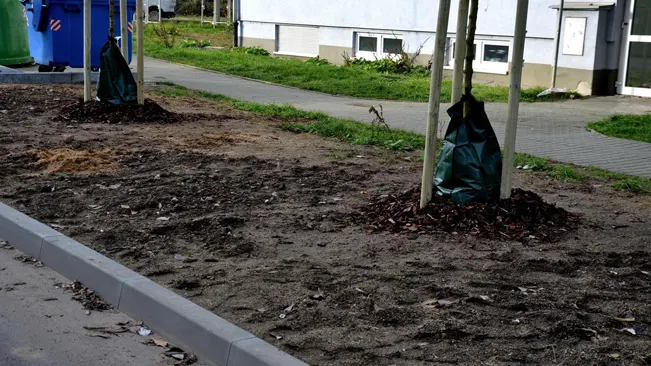
- Purpose: Mulch serves several key functions in tree care. It helps retain soil moisture, which is essential for the tree’s hydration, especially in warmer months. Mulch also helps regulate soil temperature, keeping roots cooler in summer and warmer in winter.
- Material Choice: Organic mulches like wood chips, bark, or compost are commonly used. These materials gradually break down, adding nutrients to the soil and improving its structure.
- Application: When mulching, spread a 2-4 inch layer around the base of the tree. It’s crucial to avoid piling mulch directly against the tree trunk as this can cause moisture to accumulate against the bark, leading to rot or disease.
- Maintenance: Mulch should be checked and replenished annually to maintain an adequate layer. As it decomposes, it will need to be topped up to continue providing benefits.
Fertilizing
- Purpose: Fertilizing provides essential nutrients that might not be sufficiently available in the soil. For maple trees, this promotes healthy growth and vigor.
- Type of Fertilizer: A balanced, slow-release fertilizer is recommended. This type of fertilizer releases nutrients gradually, providing a steady supply over time. The term “balanced” refers to an equal or harmonious proportion of essential nutrients, typically nitrogen, phosphorus, and potassium.
- Timing: The best time to fertilize is in early spring, just as the tree begins a new growth cycle. Fertilizing at this time ensures that the tree has access to nutrients during its most active growing period.
- Application Method: The fertilizer should be applied around the drip line of the tree, which is the area directly beneath the outer circumference of the tree branches. Avoid applying fertilizer too close to the trunk.
- Monitoring: Observe the tree’s response to fertilization. Signs of good health include robust leaf growth, vibrant color, and a strong structure. Over-fertilizing can be harmful, so it’s important to follow product instructions and not exceed recommended amounts.
Staking (If Necessary)
If your maple is young and fragile, stake it to provide support. Drive a stake into the ground next to the tree and loosely tie the tree to the stake. Remove the stake after one or two years.

Why Stake a Maple Tree?
- Support: Young trees, especially those with tall, slender trunks or those planted in windy areas, may need extra support to prevent leaning or bending.
- Root Establishment: Staking helps the tree establish its root system by reducing trunk movement. This is crucial for the tree’s long-term health and stability.
- Protection: In areas with heavy foot traffic or lawn equipment, staking can provide a visual reminder that there’s a young tree to be careful around.
How to Properly Stake a Maple Tree
- Stake Selection: Choose stakes that are sturdy and tall enough to support the tree. Typically, a stake should be about one-third to half the height of the tree.
- Positioning the Stake: Drive the stake into the ground about 15 to 18 inches from the tree’s base. Be careful not to damage the root system.
- Tying the Tree: Use a broad, flexible material like a tree staking strap or soft rope. Avoid wire or anything that can cut into the tree’s bark. Tie the tree loosely to the stake, allowing some movement. This movement is important for the tree to develop a strong trunk and root system.
- Height of Tying: The tie should be placed about two-thirds up the height of the tree. This provides stability while allowing some flexibility.
Monitoring and Maintenance
- Regular Checks: Check the ties periodically to ensure they’re not too tight, which can constrict the trunk and hinder growth.
- Adjustments: As the tree grows, you may need to adjust or move the ties to prevent damage.
- Removal of Stakes: Most trees need staking for only 1 to 2 years. After this, the tree should be strong enough to support itself. Keeping stakes for too long can lead to a weaker trunk, as the tree relies on the stake rather than developing its own strength.
Caution
- Not All Trees Need Staking: Only stake a tree if it’s necessary. If the tree is stable and in a protected area, it might not need staking at all.
- Avoid Damage: When staking, be mindful not to damage the trunk or roots of the tree. Damaging the bark can lead to disease and pest problems.
Ongoing Care
Prune your maple during dormancy to remove dead or crossing branches. Monitor for pests and diseases and treat as necessary. With proper care, your maple tree will grow strong and provide beauty for years to come.
Pruning

- When to Prune: Maple trees should be pruned during their dormant season, which is typically in late winter or early spring. This timing avoids sap loss and reduces the risk of pest invasion or disease infection.
- Objective: The main goals of pruning are to maintain the tree’s shape, remove damaged or diseased branches, and prevent branches from crossing or rubbing against each other, which can cause wounds and make the tree vulnerable to diseases.
- Technique: Use clean, sharp tools. Make cuts at a 45-degree angle, about a quarter-inch above a bud facing the outside of the tree. This encourages growth away from the center of the tree. Avoid topping the tree, as this can lead to poor growth and tree health.
Pest and Disease Management
- Common Pests: Aphids, scale insects, and mites are common pests that can affect maple trees. These insects can sap strength from the tree and lead to sooty mold.
- Diseases: Maples are susceptible to diseases like Verticillium wilt, tar spot, and various fungal infections. Symptoms include discolored leaves, cankers, or a general decline in tree health.
- Management: Regular monitoring is key. If pests or diseases are detected, identify the specific issue and treat it accordingly. This might include mechanical removal, pruning, or the application of appropriate fungicides or pesticides. In some cases, especially for serious diseases, consulting a professional arborist is recommended.
Conclusion
In conclusion, planting a maple tree requires careful site selection, proper soil preparation, and attentive planting techniques to ensure healthy growth. Regular maintenance, including watering, pruning, and monitoring for pests and diseases, is crucial for the tree’s long-term health and vibrancy. By following these guidelines, a maple tree can become a magnificent and enduring addition to any landscape, offering environmental benefits and aesthetic pleasure for years to come.
FAQs (Frequently Asked Questions)
- What is the best time of year to plant a maple tree?
- Maple trees are best planted in early spring or fall, when the weather is cooler and the trees are dormant or entering dormancy.
- Maple trees are best planted in early spring or fall, when the weather is cooler and the trees are dormant or entering dormancy.
- How much sunlight does a maple tree need?
- Most maple trees require full to partial sunlight, meaning at least 4-6 hours of direct sunlight per day.
- Most maple trees require full to partial sunlight, meaning at least 4-6 hours of direct sunlight per day.
- How often should I water a newly planted maple tree?
- Water newly planted maples deeply once a week, allowing the soil to dry out slightly between waterings.
- Water newly planted maples deeply once a week, allowing the soil to dry out slightly between waterings.
- What type of soil is ideal for maple trees?
- Maples thrive in well-drained, slightly acidic to neutral pH soil. Amending the soil with organic matter can improve soil quality.
- Maples thrive in well-drained, slightly acidic to neutral pH soil. Amending the soil with organic matter can improve soil quality.
- How far away from my house should I plant a maple tree?
- Plant maple trees at least 15-20 feet away from buildings to accommodate their root system and canopy spread as they mature.
- Plant maple trees at least 15-20 feet away from buildings to accommodate their root system and canopy spread as they mature.
- Do I need to fertilize my maple tree after planting?
- Initially, focus on establishing roots rather than encouraging growth. You can start fertilizing a year after planting, using a balanced, slow-release fertilizer.
- Initially, focus on establishing roots rather than encouraging growth. You can start fertilizing a year after planting, using a balanced, slow-release fertilizer.
- How do I choose the right maple tree species for my region?
- Consult a local nursery or agricultural extension office to find species that are well-suited to your region’s climate and soil conditions.
- Consult a local nursery or agricultural extension office to find species that are well-suited to your region’s climate and soil conditions.
- Can maple trees grow in pots?
- Smaller species like Japanese Maples can be grown in pots, but larger species need ground planting due to their extensive root systems.
- Smaller species like Japanese Maples can be grown in pots, but larger species need ground planting due to their extensive root systems.
- When and how should I prune my maple tree?
- Prune during late winter or early spring when the tree is dormant. Focus on removing dead, damaged, or crossing branches to maintain tree health and shape.
- Prune during late winter or early spring when the tree is dormant. Focus on removing dead, damaged, or crossing branches to maintain tree health and shape.
- How do I protect my young maple tree from pests and diseases?
- Regularly inspect for signs of pests or diseases. Maintain good tree health through proper watering, mulching, and pruning as a first line of defense. Consult a professional for specific treatments if problems arise.
For more expert gardening and advice, explore our guides, discover top recommendations in our best section, and delve into in-depth product reviews in our review section. Happy Gardening.

Kristine Moore
Forestry AuthorI'm Kristine Moore, a seasoned garden landscaping professional with over 30 years of experience. My extensive career has been dedicated to transforming outdoor spaces into stunning, sustainable landscapes. With a deep understanding of horticulture, design principles, and environmental stewardship, I have become a respected figure in the field, known for creating harmonious, visually appealing, and eco-friendly gardens. My commitment to excellence and continuous learning in landscaping trends and techniques has solidified my reputation as an expert in garden design and implementation.


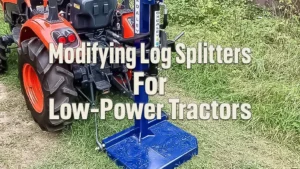










Leave your comment